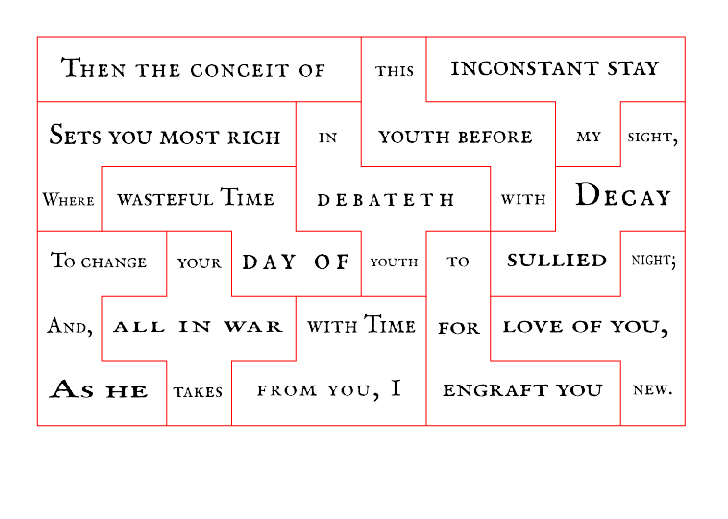
If a puzzle designer distributes the words of an existing poem into a grid in which each square corresponds to a syllable, the resulting poem can be readily converted to a polyomino puzzle by following these two rules (there are other ways to make puzzles, of course, but this is the method we are exploring first):
Rule #1. Cut the poem up by assigning a predetermined number of words or syllables to a piece.
We call this “piecifying” the poem. (The coinage is Jeremy Little’s.) In piecification the poem is dissected or pulled apart into contiguous polygons. This effort inverts the logic of the classic polyomino “packing” problems, which ask how many ways a set of shapes can be fit to a frame, but is, of course, analytically related.
Our group has so far favored reducing a poem to a set of regular pentominos, the polygon in the plane made of five squares, connected edge to edge. Some poems we have piecified by hand, others we have piecified by means of computation. The twelve unique pentomino shapes are well understood by puzzle enthusiasts, who have constructed and solved a variety of rectangular pentomino puzzles. Pentominos have an alphabetic look and are named by the letters they resemble: F, I, L, N, P, T, U, V, W, X, Y, Z. For this reason, too, we endorse their geometry.
As students of literature, we were excited to find that the 12 unique pentominos can be packed into a 6x10 frame, the shape of a sestet.

Rule #2. When cutting, do not divide words.
In piecification, we also recommend that the puzzle designer try to capture related words on single piece. Two or three vertically contiguous words, gathered from consecutive lines, will often join to form a new poetic phrase. When a poem is dissected by means of an algorithm, these contiguities are accidents of dissection.
Empuzzled phrases we’ve located include “A mightier tyrant” or “must forsake others” (Shakespeare), “of little recall” (Christina Rossetti), and many other constituents.
In a regular sonnet, there are 140 squares: where each square corresponds to a syllable. Most sonnets can therefore be piecified into 28 pentomino shapes. More interesting are the ways in which the octave or sestet can be dissected separately. More on our efforts to piecify octaves in what follows.